翻译文章
中英翻译文章阅读
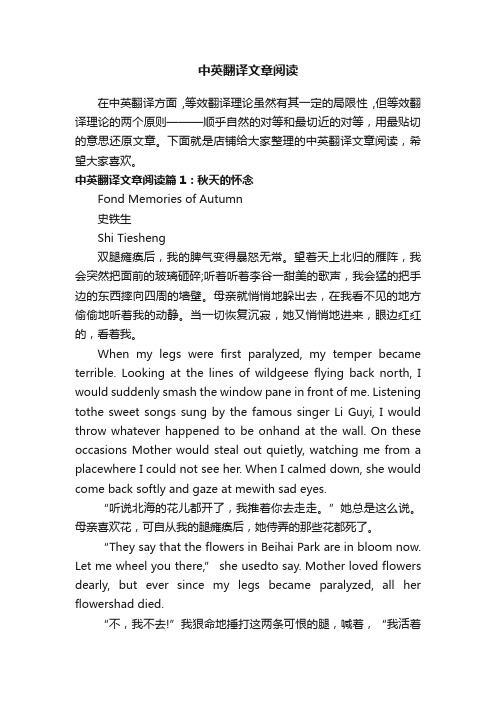
中英翻译文章阅读在中英翻译方面,等效翻译理论虽然有其一定的局限性,但等效翻译理论的两个原则———顺乎自然的对等和最切近的对等,用最贴切的意思还原文章。
下面就是店铺给大家整理的中英翻译文章阅读,希望大家喜欢。
中英翻译文章阅读篇1:秋天的怀念Fond Memories of Autumn史铁生Shi Tiesheng双腿瘫痪后,我的脾气变得暴怒无常。
望着天上北归的雁阵,我会突然把面前的玻璃砸碎;听着听着李谷一甜美的歌声,我会猛的把手边的东西摔向四周的墙壁。
母亲就悄悄地躲出去,在我看不见的地方偷偷地听着我的动静。
当一切恢复沉寂,她又悄悄地进来,眼边红红的,看着我。
When my legs were first paralyzed, my temper became terrible. Looking at the lines of wildgeese flying back north, I would suddenly smash the window pane in front of me. Listening tothe sweet songs sung by the famous singer Li Guyi, I would throw whatever happened to be onhand at the wall. On these occasions Mother would steal out quietly, watching me from a placewhere I could not see her. When I calmed down, she would come back softly and gaze at mewith sad eyes.“听说北海的花儿都开了,我推着你去走走。
”她总是这么说。
母亲喜欢花,可自从我的腿瘫痪后,她侍弄的那些花都死了。
“They say that the flowers in Beihai Park are in bloom now. Let me wheel you there,” she usedto say. Mother loved flo wers dearly, but ever since my legs became paralyzed, all her flowershad died.“不,我不去!”我狠命地捶打这两条可恨的腿,喊着,“我活着有什么劲!”母亲扑过来抓住我的手,忍住哭声说:“咱娘儿俩在一块儿,好好儿活,好好儿活……”“No, I won’t go!” I shouted, while beating my cursed legs as hard as I could. “What am I stillliving for?” Mother would then rush up to me, holding my hands in hers and saying betweensubdued sobs, “The two of us should live together happily, happily…”可我却一直都不知道,她的病已经到了那步田地。
优美英语文章带翻译(优秀7篇)
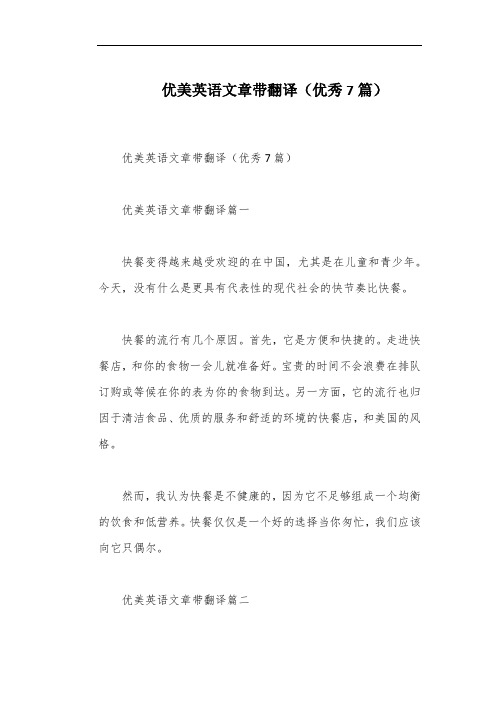
优美英语文章带翻译(优秀7篇)优美英语文章带翻译(优秀7篇)优美英语文章带翻译篇一快餐变得越来越受欢迎的在中国,尤其是在儿童和青少年。
今天,没有什么是更具有代表性的现代社会的快节奏比快餐。
快餐的流行有几个原因。
首先,它是方便和快捷的。
走进快餐店,和你的食物一会儿就准备好。
宝贵的时间不会浪费在排队订购或等候在你的表为你的食物到达。
另一方面,它的流行也归因于清洁食品、优质的服务和舒适的环境的快餐店,和美国的风格。
然而,我认为快餐是不健康的,因为它不足够组成一个均衡的饮食和低营养。
快餐仅仅是一个好的选择当你匆忙,我们应该向它只偶尔。
优美英语文章带翻译篇二Threepassions,simplebutoverwhelminglystrong,havegoverned mylife:thelongingforlove,thesearchforknowledge,andunbearablepit yforthesufferingofmankind.Thesepassions,likegreatwinds,haveblow nmehitherandthither,inawaywardcourse,overadeepoceanof anguish,reachingtotheveryvergeofdespair.Ihavesoughtlove,first,becauseitbringsecstasy–ecstasysogreatthatIwouldoftenhavesacrificedalltherestoflifeforafew hoursofthisjoy.Ihavesoughtit,next,becauseitrelievesloneliness-thatterriblelone linessinwhichoneshiveringconsciousnesslooksovertherimoftheworld intothecoldunfathomablelifelessabyss.Ihavesoughtit,finally,becausei ntheunionofloveIhaveseen,inamysticminiature,theprefiguringvisionoftheheaventhatsaintsandpoetshaveimagined.ThisiswhatIsoug ht,andthoughitmightseemtoogoodforhumanlife,thisiswhat-atlast-Ih avefound.WithequalpassionIhavesoughtknowledge.Ihavewishedtounders tandtheheartsofmen.IhavetriedtoapprehendthePythagoreanpower bywhichnumberholdsswayabovetheflu.Alittleofthis,butnotmuch,Ihaveachieved.Loveandknowledge,sofarastheywerepossible,ledupwardtoward theheavens.Butalwayspitybroughtmebacktoofcriesofpainreverberat einmyheart.Childreninfamine,victimstorturedbyoppressors,helpless oldpeopleahatedburdentotheirsons,andthewholeworldof loneliness,poverty,andpainmakeamockeryofwhathumanlifesho uldbe.Ilongtoalleviatetheevil,butIcannot,andItoosuffer.Thishasbeenmylife.Ihavefounditworthliving,andwouldgladlylive itagainifthechancewereofferedme.三种激情虽然简单,却异常强烈,它们统治着我的生命,那便是:对爱的渴望,对知识的追求,以及对人类苦难的难以承受的同情。
中英文文章翻译
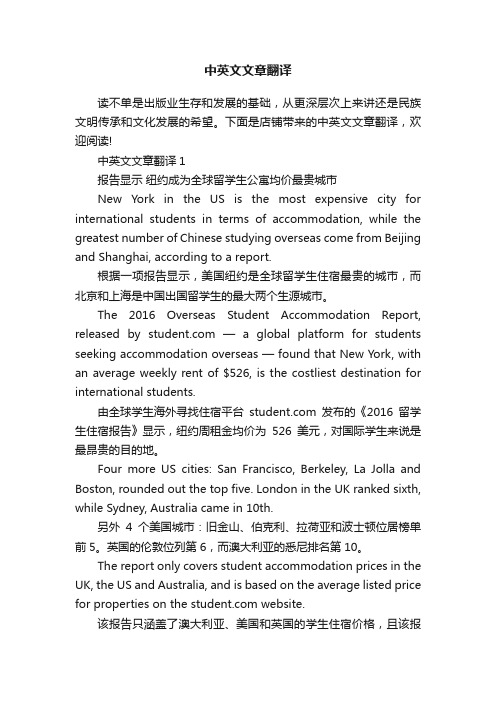
中英文文章翻译读不单是出版业生存和发展的基础,从更深层次上来讲还是民族文明传承和文化发展的希望。
下面是店铺带来的中英文文章翻译,欢迎阅读!中英文文章翻译1报告显示纽约成为全球留学生公寓均价最贵城市New York in the US is the most expensive city for international students in terms of accommodation, while the greatest number of Chinese studying overseas come from Beijing and Shanghai, according to a report.根据一项报告显示,美国纽约是全球留学生住宿最贵的城市,而北京和上海是中国出国留学生的最大两个生源城市。
The 2016 Overseas Student Accommodation Report, released by — a global platform for students seeking accommodation overseas — found that New York, with an average weekly rent of $526, is the costliest destination for international students.由全球学生海外寻找住宿平台发布的《2016留学生住宿报告》显示,纽约周租金均价为526美元,对国际学生来说是最昂贵的目的地。
Four more US cities: San Francisco, Berkeley, La Jolla and Boston, rounded out the top five. London in the UK ranked sixth, while Sydney, Australia came in 10th.另外4个美国城市:旧金山、伯克利、拉荷亚和波士顿位居榜单前5。
英文文章带翻译
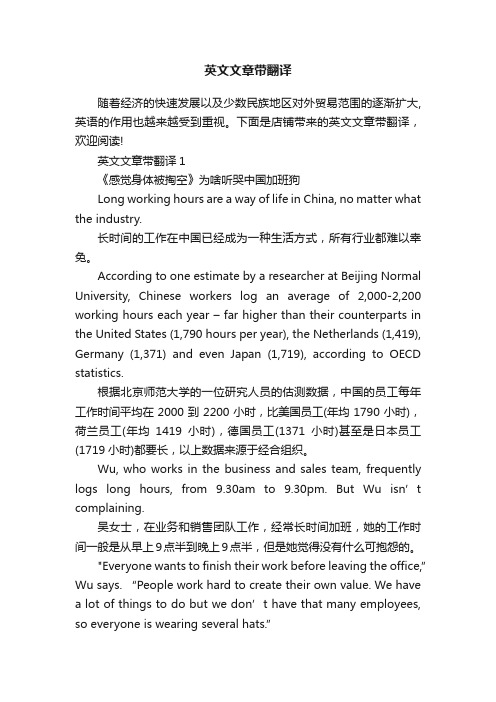
英文文章带翻译随着经济的快速发展以及少数民族地区对外贸易范围的逐渐扩大,英语的作用也越来越受到重视。
下面是店铺带来的英文文章带翻译,欢迎阅读!英文文章带翻译1《感觉身体被掏空》为啥听哭中国加班狗Long working hours are a way of life in China, no matter what the industry.长时间的工作在中国已经成为一种生活方式,所有行业都难以幸免。
According to one estimate by a researcher at Beijing Normal University, Chinese workers log an average of 2,000-2,200 working hours each year – far higher than their counterparts in the United States (1,790 hours per year), the Netherlands (1,419), Germany (1,371) and even Japan (1,719), according to OECD statistics.根据北京师范大学的一位研究人员的估测数据,中国的员工每年工作时间平均在2000到2200小时,比美国员工(年均1790小时),荷兰员工(年均1419小时),德国员工(1371小时)甚至是日本员工(1719小时)都要长,以上数据来源于经合组织。
Wu, who works in the business and sales team, frequently logs long hours, from 9.30am to 9.30pm. But Wu isn’t complaining.吴女士,在业务和销售团队工作,经常长时间加班,她的工作时间一般是从早上9点半到晚上9点半,但是她觉得没有什么可抱怨的。
经典英语文章翻译

经典英语文章翻译经典文章阅读对英语专业学生文化素质的养成具有无可替代的作用。
下面是店铺带来的经典英语文章翻译,欢迎阅读!经典英语文章翻译1We've all heard the quote, 'Be Kind, for everyone you meet is fighting a hard battle.'我们都听过这句话:“要善良,因为你遇到的每个人都在经历某种痛苦。
”My husband and son died within two years of each other. From my personal experience, I believe that if we aren't careful, grief can become a rather self-involved process in which we can become so focused on our own suffering that we miss the opportunity to connect with, and possibly bring comfort to, someone else who may be going through a similar experience.我的丈夫和儿子两年内相继去世。
从我的个人经验来看,我相信我们一不小心就会被伤痛左右,以自己为中心,我们会变得过于关注自己的痛苦,而错失和正经历相似痛苦的人接触的机会,也无法给予他们安慰。
Six months after my husband died, I was sinking in the quicksand of grief. I could not pull myself out of the misery.那时,我真的认为自己的生活要比身边任何人都不容易。
生活给我上了完美的一课,通过这次不幸我认清了一个事实:顾影自怜使我看不到别人,只看到自己。
优秀英语文章带中文翻译

优秀英语文章带中文翻译多学习一些优秀文章,对我们有很大的帮助。
以下是店铺为大家整理的优秀英语文章带中文翻译(精选7篇)相关内容,仅供参考,希望能够帮助大家。
优秀英语文章带中文翻译篇1付出与收获 Hard Work and IncomeI always hear about my friends’ complaining, they say their income is such low that they can’t not make ends meet. At first, I would pity for them, but in the long run, I find their work is so easy, they just sit in the office from 9 am to 5 pm, they even don’t need to go out for business. While I see another frien d, he works so hard, his working hour is very unstable, sometimes he even works until 9 pm. The fact is that he earns the most between my friends. It is true that no pain, no gain, if people want more, they need to pay out more. Comparing to be envy about other people’s great income, we’d better to work hard to realize what we want. There is not short-cut for people to get successful, working hard is the only way.我总是听到朋友们的抱怨,他们说收入太少了,以至于无法收支平衡。
中英文对照翻译文章
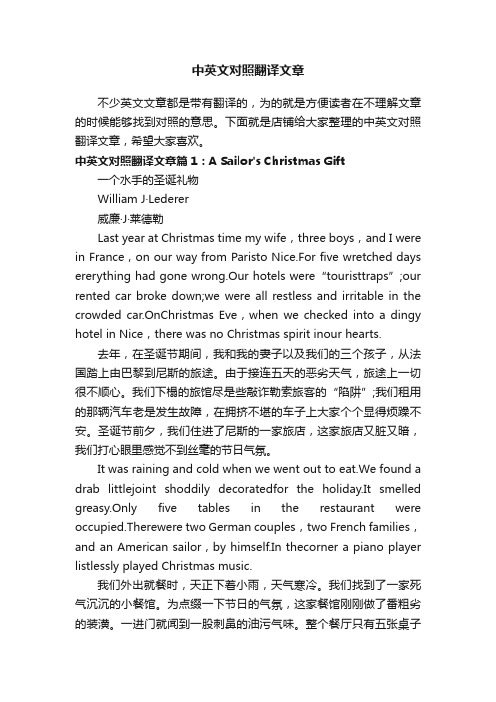
中英文对照翻译文章不少英文文章都是带有翻译的,为的就是方便读者在不理解文章的时候能够找到对照的意思。
下面就是店铺给大家整理的中英文对照翻译文章,希望大家喜欢。
中英文对照翻译文章篇1:A Sailor's Christmas Gift一个水手的圣诞礼物William J·Lederer威廉·J·莱德勒Last year at Christmas time my wife,three boys,and I were in France,on our way from Paristo Nice.For five wretched days ererything had gone wrong.Our hotels were“touristtraps”;our rented car broke down;we were all restless and irritable in the crowded car.OnChristmas Eve,when we checked into a dingy hotel in Nice,there was no Christmas spirit inour hearts.去年,在圣诞节期间,我和我的妻子以及我们的三个孩子,从法国踏上由巴黎到尼斯的旅途。
由于接连五天的恶劣天气,旅途上一切很不顺心。
我们下榻的旅馆尽是些敲诈勒索旅客的“陷阱”;我们租用的那辆汽车老是发生故障,在拥挤不堪的车子上大家个个显得烦躁不安。
圣诞节前夕,我们住进了尼斯的一家旅店,这家旅店又脏又暗,我们打心眼里感觉不到丝毫的节日气氛。
It was raining and cold when we went out to eat.We found a drab littlejoint shoddily decoratedfor the holiday.It smelled greasy.Only five tables in the restaurant were occupied.Therewere two German couples,two French families,and an American sailor,by himself.In thecorner a piano player listlessly played Christmas music.我们外出就餐时,天正下着小雨,天气寒冷。
带翻译的英语文章
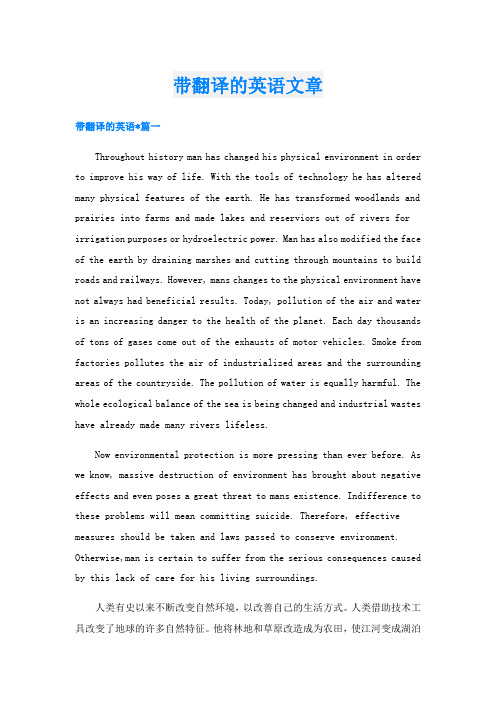
带翻译的英语文章带翻译的英语*篇一Throughout history man has changed his physical environment in order to improve his way of life. With the tools of technology he has altered many physical features of the earth. He has transformed woodlands and prairies into farms and made lakes and reserviors out of rivers for irrigation purposes or hydroelectric power. Man has also modified the face of the earth by draining marshes and cutting through mountains to build roads and railways. However, mans changes to the physical environment have not always had beneficial results. Today, pollution of the air and water is an increasing danger to the health of the planet. Each day thousands of tons of gases come out of the exhausts of motor vehicles. Smoke from factories pollutes the air of industrialized areas and the surrounding areas of the countryside. The pollution of water is equally harmful. The whole ecological balance of the sea is being changed and industrial wastes have already made many rivers lifeless.Now environmental protection is more pressing than ever before. As we know, massive destruction of environment has brought about negative effects and even poses a great threat to mans existence. Indifference to these problems will mean committing suicide. Therefore, effective measures should be taken and laws passed to conserve environment. Otherwise,man is certain to suffer from the serious consequences caused by this lack of care for his living surroundings.人类有史以来不断改变自然环境,以改善自己的生活方式。
(完整word版)英语短文带翻译20篇
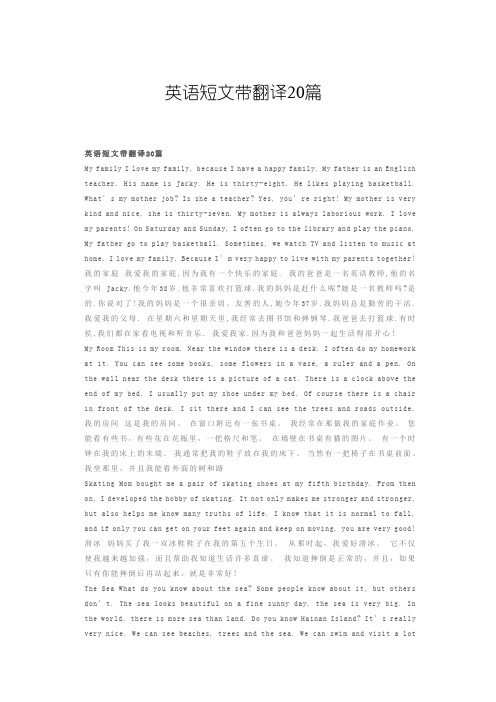
英语短文带翻译20篇英语短文带翻译20篇My family I love my family, because I have a happy family. My father is an English teacher. His name is Jacky. He is thirty-eight. He likes playing basketball. What’s my mother job? Is she a teacher? Yes, you’re right! My mother is very kind and nice, she is thirty-seven. My mother is always laborious work. I love my parents! On Saturday and Sunday, I often go to the library and play the piano, My father go to play basketball. Sometimes, we watch TV and listen to music at home. I love my family. Because I’m very happy to live with my parents together! 我的家庭我爱我的家庭,因为我有一个快乐的家庭. 我的爸爸是一名英语教师,他的名字叫Jacky.他今年38岁.他非常喜欢打篮球.我的妈妈是赶什么呢?她是一名教师吗?是的.你说对了!我的妈妈是一个很亲切、友善的人,她今年37岁.我妈妈总是勤劳的干活.我爱我的父母. 在星期六和星期天里,我经常去图书馆和弹钢琴.我爸爸去打篮球.有时侯,我们都在家看电视和听音乐. 我爱我家.因为我和爸爸妈妈一起生活得很开心!My Room This is my room. Near the window there is a desk. I often do my homework at it. You can see some books, some flowers in a vase, a ruler and a pen. On the wall near the desk there is a picture of a cat. There is a clock above the end of my bed. I usually put my shoe under my bed. Of course there is a chair in front of the desk. I sit there and I can see the trees and roads outside. 我的房间这是我的房间。
中英文互译文章

中英文互译文章翻译是在特定社会文化背景下的交流过程,是一种特殊创作。
不少中英文互译的文章对提高读者英语水平有一定的帮助。
下面就是店铺给大家整理的中英文互译文章,希望大家喜欢。
中英文互译文章篇1:On leadership论领导What is leadership?什么是领导?Its qualities are difficult to define. But they are not so difficult to identity.领导应具备什么样的素质,这很难精确的解说,但辨认直陈却也不难。
Leaders don’t force other people to go along with them. They bring them along. Leaders getcommitment from others by giving it themselves, by building an environment that encouragescreativity, and by operating with honesty and fairness.领导者不强制别人与自己协调一致,而是帮助他们跟上。
领导者让别人承担义务,首先自己承担义务,造成一种能鼓励创造的环境,待人诚恳,处事公正。
Leaders demand much of others, but also much of themselves. They are ambitions- not only forthemselves, but also for those who work with them. They seek to attract, retain and developother people to their full abilities.领导者对人要求很多,同时也给人很多。
他们有雄心壮志,不仅为自己,也为和他们一道工作的人。
英文文章翻译成中文3篇
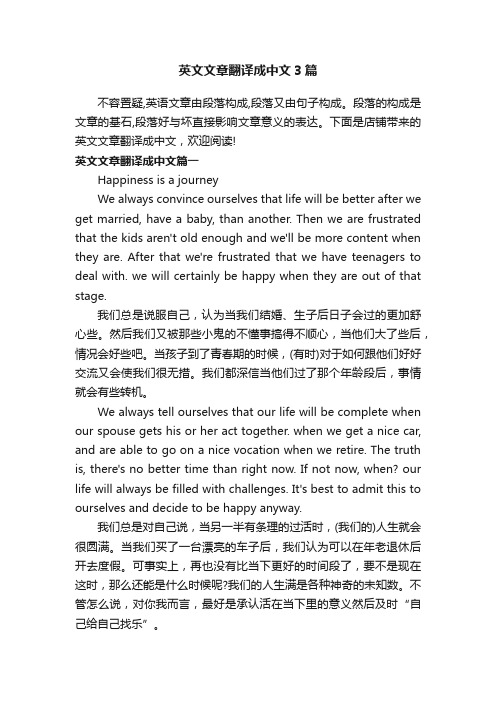
英文文章翻译成中文3篇不容置疑,英语文章由段落构成,段落又由句子构成。
段落的构成是文章的基石,段落好与坏直接影响文章意义的表达。
下面是店铺带来的英文文章翻译成中文,欢迎阅读!英文文章翻译成中文篇一Happiness is a journeyWe always convince ourselves that life will be better after we get married, have a baby, than another. Then we are frustrated that the kids aren't old enough and we'll be more content when they are. After that we're frustrated that we have teenagers to deal with. we will certainly be happy when they are out of that stage.我们总是说服自己,认为当我们结婚、生子后日子会过的更加舒心些。
然后我们又被那些小鬼的不懂事搞得不顺心,当他们大了些后,情况会好些吧。
当孩子到了青春期的时候,(有时)对于如何跟他们好好交流又会使我们很无措。
我们都深信当他们过了那个年龄段后,事情就会有些转机。
We always tell ourselves that our life will be complete when our spouse gets his or her act together. when we get a nice car, and are able to go on a nice vocation when we retire. The truth is, there's no better time than right now. If not now, when? our life will always be filled with challenges. It's best to admit this to ourselves and decide to be happy anyway.我们总是对自己说,当另一半有条理的过活时,(我们的)人生就会很圆满。
中英文翻译的文章
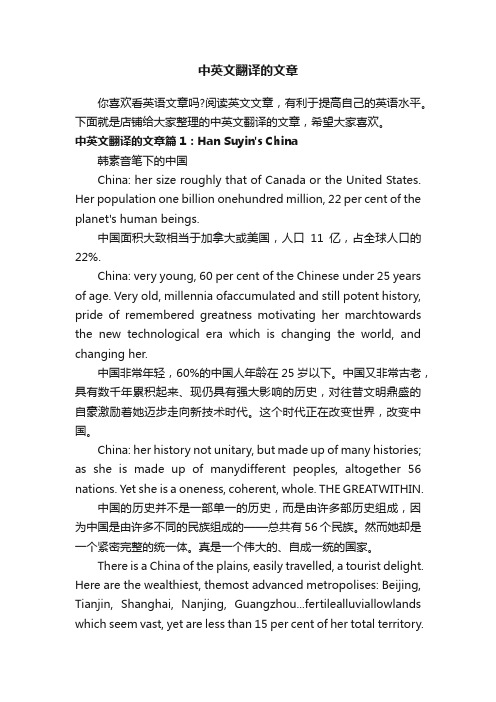
中英文翻译的文章你喜欢看英语文章吗?阅读英文文章,有利于提高自己的英语水平。
下面就是店铺给大家整理的中英文翻译的文章,希望大家喜欢。
中英文翻译的文章篇1:Han Suyin's China韩素音笔下的中国China: her size roughly that of Canada or the United States. Her population one billion onehundred million, 22 per cent of the planet's human beings.中国面积大致相当于加拿大或美国,人口11亿,占全球人口的22%.China: very young, 60 per cent of the Chinese under 25 years of age. Very old, millennia ofaccumulated and still potent history, pride of remembered greatness motivating her marchtowards the new technological era which is changing the world, and changing her.中国非常年轻,60%的中国人年龄在25岁以下。
中国又非常古老,具有数千年累积起来、现仍具有强大影响的历史,对往昔文明鼎盛的自豪激励着她迈步走向新技术时代。
这个时代正在改变世界,改变中国。
China: her history not unitary, but made up of many histories; as she is made up of manydifferent peoples, altogether 56 nations. Yet she is a oneness, coherent, whole. THE GREATWITHIN.中国的历史并不是一部单一的历史,而是由许多部历史组成,因为中国是由许多不同的民族组成的——总共有56个民族。
带翻译的英文文章

带翻译的英文文章带翻译的英文*篇1Last week, I took part in an English speech contest which was held by our teachers. There weretwelve students in the final contest. I was one of them. Fifteen minutes beforemy turn, I picked my topic and prepared for it. I wrote down the outlines and organized what I was going to say. However, when I stood in front of all judges and students, I was extremely nervous. My mind was totally empty. Then I took adeep breath to relax myself and started my speech. The result was not as good as I expected, but I preferred to regard it as a challenge to myself, whose process was the most important for me. I can learn a lot from this contest. I amsure I will be better next time.上周,我参加了学校老师举行的一次英语演讲比赛。
总共有十二位同学进入决赛,我是其中之一。
轮到我的前十五分钟,我选好我的主题并做好准备。
我写下大纲并组织好要说的内容。
但是,当我站在评委和同学们面前的时候,我就很紧张,头脑一片空白。
于是我深呼吸使自己放松然后开始演讲。
中英翻译文章
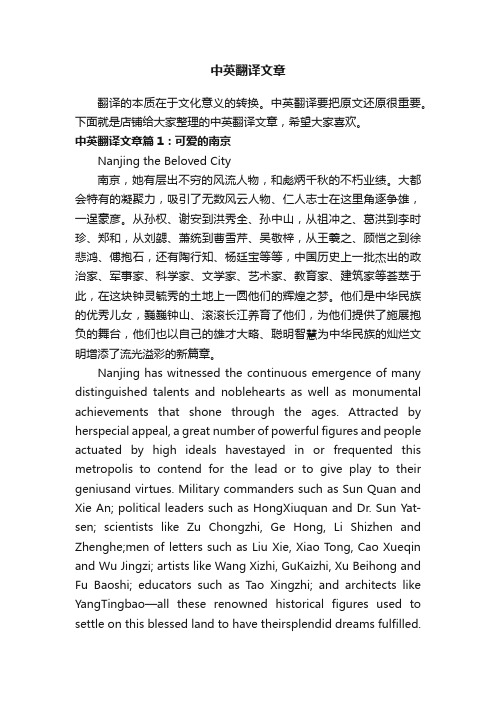
中英翻译文章翻译的本质在于文化意义的转换。
中英翻译要把原文还原很重要。
下面就是店铺给大家整理的中英翻译文章,希望大家喜欢。
中英翻译文章篇1:可爱的南京Nanjing the Beloved City南京,她有层出不穷的风流人物,和彪炳千秋的不朽业绩。
大都会特有的凝聚力,吸引了无数风云人物、仁人志士在这里角逐争雄,一逞豪彦。
从孙权、谢安到洪秀全、孙中山,从祖冲之、葛洪到李时珍、郑和,从刘勰、萧统到曹雪芹、吴敬梓,从王羲之、顾恺之到徐悲鸿、傅抱石,还有陶行知、杨廷宝等等,中国历史上一批杰出的政治家、军事家、科学家、文学家、艺术家、教育家、建筑家等荟萃于此,在这块钟灵毓秀的土地上一圆他们的辉煌之梦。
他们是中华民族的优秀儿女,巍巍钟山、滚滚长江养育了他们,为他们提供了施展抱负的舞台,他们也以自己的雄才大略、聪明智慧为中华民族的灿烂文明增添了流光溢彩的新篇章。
Nanjing has witnessed the continuous emergence of many distinguished talents and noblehearts as well as monumental achievements that shone through the ages. Attracted by herspecial appeal, a great number of powerful figures and people actuated by high ideals havestayed in or frequented this metropolis to contend for the lead or to give play to their geniusand virtues. Military commanders such as Sun Quan and Xie An; political leaders such as HongXiuquan and Dr. Sun Yat-sen; scientists like Zu Chongzhi, Ge Hong, Li Shizhen and Zhenghe;men of letters such as Liu Xie, Xiao Tong, Cao Xueqin and Wu Jingzi; artists like Wang Xizhi, GuKaizhi, Xu Beihong and Fu Baoshi; educators such as Tao Xingzhi; and architects like YangTingbao—all these renowned historical figures used to settle on this blessed land to have theirsplendid dreams fulfilled.The towering Purple Mountains and billowing Yangtze River nurturedthem and provided them with arenas in which to realize their aspirations. By virtue of theirgenius, vision, and sagacity, these best and brightest sons and daughters of the nation madespectacular contributions to the resplendent Chinese civilization.南京,她自新中国建立以来发生的巨大而深刻的变化更加使人欢欣鼓舞。
中译英文章翻译

中译英文章翻译中文和英文是两种不同的文化语言,翻译起着连接理解不同文化的关键使命,下面就是店铺给大家整理的中译英文章翻译,希望大家喜欢。
中译英文章翻译篇1:雄辩症A Case of Eloquence王蒙Wang Meng一位医生向我介绍,他们在门诊中接触了一位雄辩症病人。
医生说:“请坐。
”A doctor once told me about one of his outpatients who suffered from the disease ofeloquence: "Please sit down," the doctor told him.病人说:“为什么要坐呢?难道你要剥夺我的不坐权吗?”"Why should I?" the patient asked. "Are you going to deprive me of my right not to sit down?"医生无可奈何,倒了一杯水,说:“请喝水吧。
”The doctor could say nothing but offered him a glass of water. "Have some water then.”病人说:“这样谈问题是片面的,因而是荒谬的,并不是所有的水都能喝。
例如你如果在水里搀上氰化钾,就绝对不能喝。
”The patient retorted, “This is lop-sided talk, so it is absurd. Not all water is drinkable. If youput same potassium cyanide in it, it will be undrinkable. "医生说:“我这里并没有放毒药嘛。
你放心! ”The doctor said, "1 didn't put any poison in it. Please rest assured."病人说:“谁说你放了毒药了呢?难道我诬告你放了毒药?难道检察院起诉书上说你放了毒药?我没说你放毒药,而你说我说你放了毒药,你这才是放了比毒药还毒的毒药!”"Who said you put poison in it? Do you mean to say that I am lodging a false accusationagainst you? Has it been written cat the indictment of the procurator that you have putpoison in the water? I didn't say you had put poison in it, but you claimed that I said you hadput poison in it. So you have indeed put in move poisonous poison against met"医生毫无办法,便叹了口气,换一个话题说:“今天天气不错。
英语文章阅读带翻译3篇

英语文章阅读带翻译3篇在世界经济全球化及中国加入WTO的形势下,社会需要大量能够用英语在国际上进行科技、经贸、法律和文化等方面交流的专业人才。
下面是店铺带来的英语文章阅读带翻译,欢迎阅读!英语文章阅读带翻译篇一In the public interestThe Scandinavian countries are much admired all over the world for their enlightened social policies. Sweden has evolved an excellent system for protecting the individual citizen from high-handed or incompetent public officers. The system has worked so well, that it has been adopted in other countries like Denmark, Norway, Finland, and New Zealand. Even countries with large populations like Britain and the United States are seriously considering imitating the Swedes.The Swedes were the first to recognize that public officials like civil servants, collectors can make mistakes or act over-zealously in the belief that they are serving the public. As long ago as 1809, the Swedish Parliament introduced a scheme to safeguard the interest of the individual. A parliamentary committee representing all political parties appoints a person who is suitably qualified to investigate private grievances against the State. The official title of the person is 'Justiteombudsman', but the Swedes commonly refer to him as the 'J.O.' or 'Ombudsman'. The Ombudsman is not subject to political pressure. He investigates complaints large and small that come to him from all levels of society. As complaints must be made in writing, the Ombudsman receives an average of 1200 letters a year. He has eight lawyer assistants to help him and he examines every single letter in detail. There is nothing secretive about theOmbudsman's work, for his correspondence is open to public inspection. If a citizen's complaint is justified, the Ombudsman will act on his behalf. The action he takes varies according to the nature of the complaint. He may gently reprimand an official or even suggest to parliament that a law be altered. The following case is a typical example of the Ombudsman's work.A foreigner living in a Swedish village wrote to the Ombudsman complaining that he had been ill-treated by the police, simply because he was a foreigner. The Ombudsman immediately wrote to the Chief of Police in the district asking him to send a record of the case. There was nothing in the record to show that the foreigner's complaint was justified and the Chief of Police stoutly denied the accusation. It was impossible for the Ombudsman to take action, but when he received a similar complaint from another foreigner in the same village, he immediately sent one of his lawyers to investigate the matter. The lawyer ascertained that a policeman had indeed dealt roughly with foreigners on several occasions. The fact that the policeman was prejudiced against foreigners could not be recorded in he official files. It was only possible for the Ombudsman to find this out by sending one of his representatives to check the facts. The policeman in question was severely reprimanded and was informed that if any further complaints were lodged against him, he would be prosecuted. The Ombudsman's prompt action at once put an end to an unpleasant practice which might have gone unnoticed.斯堪的纳维亚半岛各国实行开明的社会政策,受到全世界的推崇。
英文文章带翻译

英文文章带翻译英语文章的难度是存在等级的,而难度的划分有很多原则。
下面是店铺带来的英文文章带翻译,欢迎阅读!英文文章带翻译篇一热爱生活 (Love Your Life )Henry David Thoreau 享利•大卫•梭罗However mean your life is,meet it and live it ;do not shun it and call it hard names.It is not so bad as you are.It looks poorest when you are richest.The fault-finder will find faults in paradise.Love your life,poor as it is.You may perhaps have some pleasant,thrilling,glorious hourss,even in a poor-house.The setting sun is reflected from the windows of the alms-house as brightly as from the rich man's abode;the snow melts before its door as early in the spring.I do not see but a quiet mind may live as contentedly there,and have as cheering thoughts,as in a palace.The town's poor seem to me often to live the most independent lives of any.May be they are simply great enough to receive without misgiving.Most think that they are above being supported by the town;but it often happens that they are not above supporting themselves by dishonest means.which should be more disreputable.Cultivate poverty like a garden herb,like sage.Do not trouble yourself much to get new things,whether clothes or friends,Turn the old,return to them.Things do not change;we change.Sell your clothes and keep your thoughts.不论你的生活如何卑贱,你要面对它生活,不要躲避它,更别用恶言咒骂它。
英语文章翻译
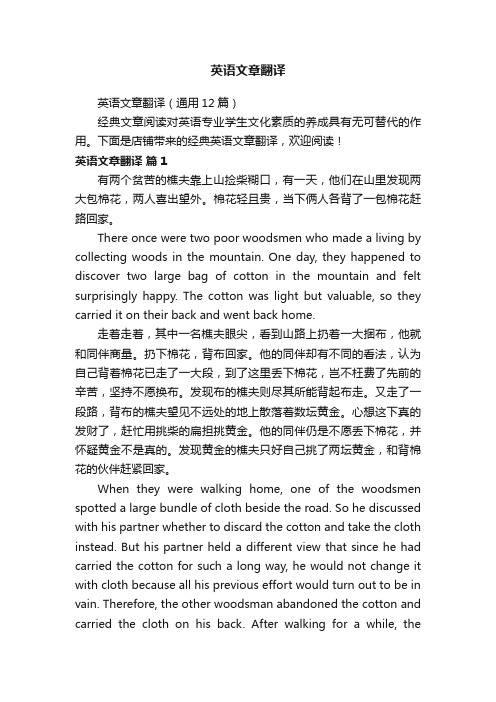
英语文章翻译英语文章翻译(通用12篇)经典文章阅读对英语专业学生文化素质的养成具有无可替代的作用。
下面是店铺带来的经典英语文章翻译,欢迎阅读!英语文章翻译篇1有两个贫苦的樵夫靠上山捡柴糊口,有一天,他们在山里发现两大包棉花,两人喜出望外。
棉花轻且贵,当下俩人各背了一包棉花赶路回家。
There once were two poor woodsmen who made a living by collecting woods in the mountain. One day, they happened to discover two large bag of cotton in the mountain and felt surprisingly happy. The cotton was light but valuable, so they carried it on their back and went back home.走着走着,其中一名樵夫眼尖,看到山路上扔着一大捆布,他就和同伴商量。
扔下棉花,背布回家。
他的同伴却有不同的看法,认为自己背着棉花已走了一大段,到了这里丢下棉花,岂不枉费了先前的辛苦,坚持不愿换布。
发现布的樵夫则尽其所能背起布走。
又走了一段路,背布的樵夫望见不远处的地上散落着数坛黄金。
心想这下真的发财了,赶忙用挑柴的扁担挑黄金。
他的同伴仍是不愿丢下棉花,并怀疑黄金不是真的。
发现黄金的樵夫只好自己挑了两坛黄金,和背棉花的伙伴赶紧回家。
When they were walking home, one of the woodsmen spotted a large bundle of cloth beside the road. So he discussed with his partner whether to discard the cotton and take the cloth instead. But his partner held a different view that since he had carried the cotton for such a long way, he would not change it with cloth because all his previous effort would turn out to be in vain. Therefore, the other woodsman abandoned the cotton and carried the cloth on his back. After walking for a while, thewoodsman who carried the cloth spotted several jars of gold disseminated on the ground not far away. He felt so thrilled that he was going to be a wealthy man. So he gave up the cloth and used his carrying pole to carry two jars of gold, while his partner was still reluctant to abandon the cotton and wondering whether the gold was real or not.谁知道刚走到山下。
- 1、下载文档前请自行甄别文档内容的完整性,平台不提供额外的编辑、内容补充、找答案等附加服务。
- 2、"仅部分预览"的文档,不可在线预览部分如存在完整性等问题,可反馈申请退款(可完整预览的文档不适用该条件!)。
- 3、如文档侵犯您的权益,请联系客服反馈,我们会尽快为您处理(人工客服工作时间:9:00-18:30)。
AppendixResearch Car from the AcademeFrom October, 1979 to September, 1981, about 35 student engineers and instructors at four technical universities in West Germany worked full time to create a research car. They were sponsored in part by a grant from the BMFT. The project was coordinated by Professor Bert Breuer in Darmstadt.The result is a roomy family car with sedan/wagon profile, diesel power, and front-wheel drive. The project came into being under the same BMFT program in which Audi, Mercedes-Benz, and V olkswagen participated. But in September, 1981 it was announced that only the Uni-Car (University-Car) qualified for continued BMFT funds. Support for the other projects was terminated. This left the car companies to pursue their research an development work independently.Whether the Uni-Car is better than what the motor industry can com up with or not, it is worth a closer look. A lot of thought has gone into it, and some of the solutions are daring yet realistic. The universities placed greater emphasis on passive safety than the car companies. Throughout the car, its designers have aimed for new solutions in simplified maintenance, easier repairs, and longer life. Suitability for mass production also has been a fundamental requirement.Foremost among the design objectives was a 25-mpg average fueleconomy for a four seater with 900 pounds payload capacity and a range of 250 miles. Moreover, it should have a top speed of at least 90 mph and be able to accelerate from 0 to 60 mph in no more than 13 seconds. Other goals concerned noise, exhaust emissions, durability, recyclability, and energy use during manufacture. It is not a production prototype, but a carrier of ideas that can help put new solutions into the service of the industry.The Uni-Car was designed for a 108.3 inch wheelbase with a track of 57 inches in front and 54.3 inches in the rear. Its overall dimensions are 181.1 inches in length, 69 inches in width, and 54 inches in height—running on 175 HR-15 tires.The weight target was 2756 pounds maximum (anything lighter would have been preferable).But during the construction period, it was found that the target could not be met, and the prototype ended up with a dry weight of 3032 pounds.The team from the Stuttgart Technical University, led by Professor Ulf Essers, was assigned the body design, aerodynamics, ventilation, and noise control. The wind tunnel work and consequent modifications were carried out by Jurgen Potthoff.Professor Hermann Appel and Professor Hans-Peter Willumeit of the Technical University of Berlin led the team that concentrated on body structure, ergometrics, occupant protection, interior layout, andnonaggressivity to pedestrians. Thus there was close cooperation between the two teams from beginning to end. Karosseriewerk Karmann was brought in as a subcontractor for the actual building of the body. The main structure is made of steel. The roof is a sheet-steel panel, but the doors and tailgate are made of aluminum to save weight. The hood is mainly plastic, and attached to an aluminum frame.Once the basic interior space requirements had been formulated, body design was directed by aerodynamic principles. Four different shapes were tested on 1/5 scale models in the wind tunnel, and the Kamm-back winner was chosen for further development. The final model proved to have a Cx as low as 0.226. That led the team to the conclusion that a drag coefficient not exceeding same design. In fact, the basic shape was so favorable, and Potthoff’s fine-tuning so successful, that the actual car has drag coefficient as low as 0.24. “And further improvement is still possible,” says Potthoff.Among its notable design features is the smoothly rounded nose where bumper, lamps, and plastic hood blend into an unbroken surface. The body has a pronounced taper from the A-post to the rear end panel. The small, silenced air intake integrated with the bumper, air extractors in the forward edge of the front doors, faired-in outside mirrors, flush-fitting wheel covers and full-panel rear fenders, play small but vital roles. Various refinements were added for their potential role in adding toactive safety. For instance, the big housings for the outside mirrors also contain wiper mechanisms for the wiper arms that sweep the front door windows. The mirrors are not unusually big. The size of housings is due to the requirement for allowing the mirrors to yield in impacts with pedestrians. At the same time, the springs and hinges must be sufficiently strong to prevent accidental damage, and the linkage could not be miniaturized.The steering wheel is taken from a BMW. And VDO supplied the instrumentation using liquidcrystal displays.In addition to the energy-absorbing front end and the side-impact protection built into the doors, the Berlin team made some interesting decisions. They decided to fix the front seat in place and back it up with a steel bulk-head running the full width of the car (form B-post to B-post). That will guarantee adequate survival apace even in a frontal collision at any speed where seat belts will save the occupants.Fixing the seat made it necessary to provide a wide range of adjustment for the pedals as well as the steering wheel. The seat belts do not have their locks in the middle of the car —as is common practice because the B-post makes the most convenient anchorage point for the upper-torso end of the belt —but next to the doors so as to facilitate unlocking by outside persons coming to the rescue after an accident . The upper-torso anchorages take the form of a bracket on the roof-height crossbar formingpart of the central bulkhead.The team from the Technical University of Aachen, led by Professor Jurgen Helling, was responsible for most of the Uni-Car chassis (the brakes were done in Stuttgart).The chassis has all-independent suspension with automatic level control at the rear end, four-wheel disc brakes with ABS antilock, and recirculating-ball, low-energy-loss power steering. The level control is not just a comfort feature, but plays a part in the aerodynamics because the body attitude can affect the air flow. Responsibility for the engine tested with the Stuttgart team. They subcontracted with the big truck and engine makers of Munich, M.A.N. to build a 2.5-liter, four-cylinder diesel engine. It is turbocharged and delivers 98 hp. Fully encapsulated in its compartment, its noise pollution is insignificant. Because of the engine dimensions and the lack of width between the front wheel housings, it became impossible to mount it transversely as had been the original intention. Instead it was mounted longitudinally , and tilted at 45 degrees to the right to avoid putting bulges in the hood.The four universities agreed that with a front-mounted engine, it is logical to drive the front wheels even in a vehicle of this type and size. The transmission was Aachen’s task, and the choice fell on an experimental stepless drive under development by Van Doorne (Transmatic).Tests with the four prototypes assemble at the Darmstadt Technical University began early in 1982. The Uni-Car vastly surpassed its top-speed target—reaching 120-125 mph without difficulty. The acceleration target also was comfortably met. But the fuel economy? Considering the weight and payload capacity of Uni-Car, it is outstanding. At a constant 56 mph it gives 51mpg. Cruising at 74.5 mph it gives 39 mpg. And in the urban driving cycle it is a real winner at 30 mpg. Professor Bert Breuer at Darmstadt is pleased with the results, so far, and foresees two important consequences of this work. First, he looks forward to a greater readiness in the automobile industry to accept new technology from academic sources.Second, he expects the Uni-Car to generate more interest in auto engineering at the high-school level and bring in higher numbers of engineering students to the universities.附录学术角度的汽车研究从1979年10月到到1981年12月来自德国西部四所技术型大学的35个学生工程师和结构设计生利用全职时间创作了一辆研究型汽车。
